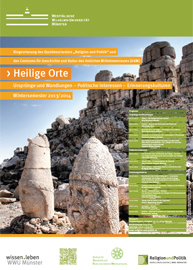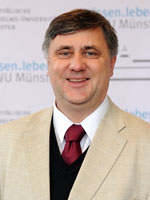The Fascination with Holy Places
Delphi, Rome, Jerusalem: renowned researchers investigate religious sites from antiquity until today – lecture series at the Cluster of Excellence starting 22 October
Tuesdays, from 6.15 to 7.45 p.m., Lecture hall F1 at the Fürstenberghaus, Domplatz 20-22

At the Cluster of Excellence “Religion and Politics” of the University of Münster, renowned researchers will investigate the fascination with holy places like Delphi, Jerusalem, Medina and Rome in the coming months. “Ever since antiquity, religious sites have lost nothing of their appeal to believers and nonbelievers alike”, says Prof. Dr. Reinhard Achenbach, Old Testament biblical scholar and member of the research association’s Board of Directors. “Tourist attractions such as the temples of the pharaohs, the Delphi oracle or the Vatican prove that.” At the same time, holy places were often embattled both politically and religiously, as is the case in Jerusalem today. As of 22 October, scholars from Archaeology, Egyptology, Islamic Studies and Theology will present their research and findings in the public lecture series “Holy Places”. Their lives’ work is closely linked to prominent religious sites. The Cluster of Excellence and the Centre for the History and Culture of the Eastern Mediterranean (Centrum für Geschichte und Kultur des östlichen Mittelmeerraums, GKM) will host the series.
Read more
“Holy places have always provided mankind with a meaning of life and an answer to existential questions”, according to the GKM’s speaker, Prof. Achenbach. “They were often created at distinguished natural sites, for example at springs, on mountains or in the desert. Religious communities linked mythical stories and magical rituals to them.” Even the oldest sacred sites of mankind, such as the Turkish mountain sanctuary Göbekli Tepe, served the cosmic orientation of the world. According to the theologian, the funerary temples in Egypt’s Abydos, for example, expressed hopes for the afterlife. Today, religious people are still looking for the meaning of life at holy places: “Jews travel to Jerusalem to pray at the Wailing Wall. Catholics go to Rome to be close to Church tradition. Muslims go on pilgrimage to Medina to be close to Mohammed and the revelation.” The first part of the lecture series will investigate the origins and transformations of holy places, the second part political interests, and the third part memory cultures of ancient sites.
Political battle for religious sites – the Mideast as an example
The political battle for religious sites characterises the history of religion and continues to this day, explains the Protestant theologian. Holy places are even destroyed in the power struggle between competing ethnic and political as well as religious groups. “In the lecture series, we aim to reveal these conflicting interests of religion and politics.” It needs to be asked, for instance, what the significance of Medina as a place of Islam’s pacification culture is for today’s culture of the Muslims, or why Rome still has such flair despite the secularisation in Europe. “And does the fact that Judaism’s, Islam’s and Christianity’s places of remembrance are in Jerusalem not hold a solution to the Middle East conflict?”
According to Prof. Achenbach, holy places often served to legitimise rulers, as was the case with the holy city of Nippur in the Ancient Orient, which is today situated in Iraq. “Later, clans gathered around the sacred site for war, and kings had their rule confirmed by oracles and religious enthronement rituals. Even today, parliaments still open their sessions with services”, says Prof. Achenbach. Christians, too, tried to erase the ancient Roman and ancient oriental religions. “This can only be recognised as a loss by looking at cultural history rationally. This is exactly why archaeologists today excavate what our ancestors destroyed.”

Prof. Dr. Reinhard Achenbach
© WWU/ Peter GrewerWhen the Delphic oracle lost its importance
Despite high costs, the scholar regards the excavations and the preservation of holy places as indispensable. “Holy places are significant for the self-awareness of man. In spite of the increasing secularisation, they should be kept in cultural memory.” Moreover, preserving sites like churches and synagogues that believers are still using in a religious manner today serves the freedom of religion. In addition, profaned churches are preserved in many places in Europe. This reminds one of the fact that these used to be religious places. Prof. Achenbach comments: “Maybe this reminds society that it is built on a tradition of values which it cannot safeguard without keeping the religious dimension.”
According to the researcher, the lecture series will also illustrate how religions may come to an end and how their claim to absoluteness breaks. “Older holy places have often been reshaped by new religions. In Doliche in Asia Minor, Roman soldiers reinterpreted the figure of an Ancient Syrian storm god; they saw in him a special manifestation of the god Jupiter. In the course of the millennia, Jerusalem has become a sacred site for three world religions, and in Rome, Christianity replaced the ancient culture.” Other places, on the other hand, lost their sacredness. “Because of Christianisation, for example, the Delphi oracle lost its role as one of the most important prophetic sites of the ancient world.”
Among the renowned guest speakers of the lecture series are the Erlangen archaeologist Prof. Dr. Klaus Schmidt, who excavated the oldest mountain sanctuary at the Göbekli Tepe in Turkey; the Würzburg archaeologist Prof. Dr. Ulrich Sinn, one of the highest authorities regarding Olympia and Delphi; and the Swiss theologian and author of a standard monograph on Jerusalem, Prof. Dr. Max Küchler. The lectures will be given on Tuesdays from 6.15 to 7.45 p.m. in lecture theatre F1 of the Fürstenberghaus at Domplatz 20-22 in Münster. Representatives of Near Eastern Antiquity Studies, Prehistoric and Protohistoric Archaeology, Ancient History, Classical Philology, Exegetics, Byzantine Studies as well as Religious and Islamic Studies will also speak. A specific feature of the lecture series is that scholars can exchange ideas with the speakers in an interdisciplinary workshop. (ska/vvm)
ProgrammE
Origins and changes |
||
| 22.10.2013 | Hans Neumann, Münster | Nippur – Die heilige Stadt der Sumerer |
| 29.10.2013 | Julia Budka, Wien | Abydos – Zentrum des Totenkultes der Pharaonen |
| 05.11.2013 | Klaus Zimmermann, Münster | Zwischen Tyros und Tanger – Die Religion der Seefahrer |
| 12.11.2013 | Reinhard Achenbach, Münster | Jerusalem in vorchristlicher Zeit: Gottesstadt im Völkerkampf |
| 19.11.2013 | Engelbert Winter, Münster | Das Heiligtum des Iuppiter Dolichenus auf dem Dülük Baba Tepesi (Südosttürkei) – Ein „Heiliger Ort“ zwischen Transformation und Kontinuität |
Political interests |
||
| 26.11.2013 | Ulrich Sinn, Würzburg | Auf der Suche nach den Wurzeln des Erfolgs – Die Rolle von Orakel und Wettkampf im Kult von Delphi und Olympia |
| 03.12.2013 | Klaus Schmidt, Erlangen-Nürnberg | Göbekli Tepe – Ein Bergheiligtum der Steinzeit |
| 10.12.2013 | Wolfgang Hübner, Münster | Roma Aeterna – Eine heilige Stadt in vorchristlicher Zeit? |
Commemorative cultures |
||
| 17.12.2013 | Johannes Hahn, Münster | Wie können Orte Christen heilig sein? – Konstantins „Entdeckung“ des Heiligen Landes und die Anfänge einer christlichen Sakraltopographie in der Spätantike |
| 07.01.2014 | Michael Grünbart, Münster | Entlegene Orte: Mönche, Einsiedler, Heilige und ihr Publikum |
| 14.01.2014 | Georgios Makris, Münster | Byzanz – Konstantinopel – Istanbul |
| 21.01.2014 | Hans G. Kippenberg, Bremen | Heilige Orte der Antike in der Gegenwart |
| 28.01.2014 | Max Küchler, Fribourg | Jerusalem – Al Quds |
| 04.02.2014 | Werner Ende, Freiburg | Medina - Stadt des Propheten und Camposanto des Islams |
Winter Semester 2013/2014
Tuesdays,18.15 bis 19.45 Uhr
Lecture hall F1 at the Fürstenberghaus
Domplatz 20-22
48143 Münster

